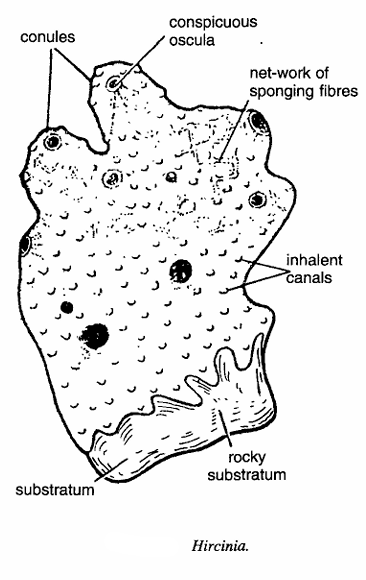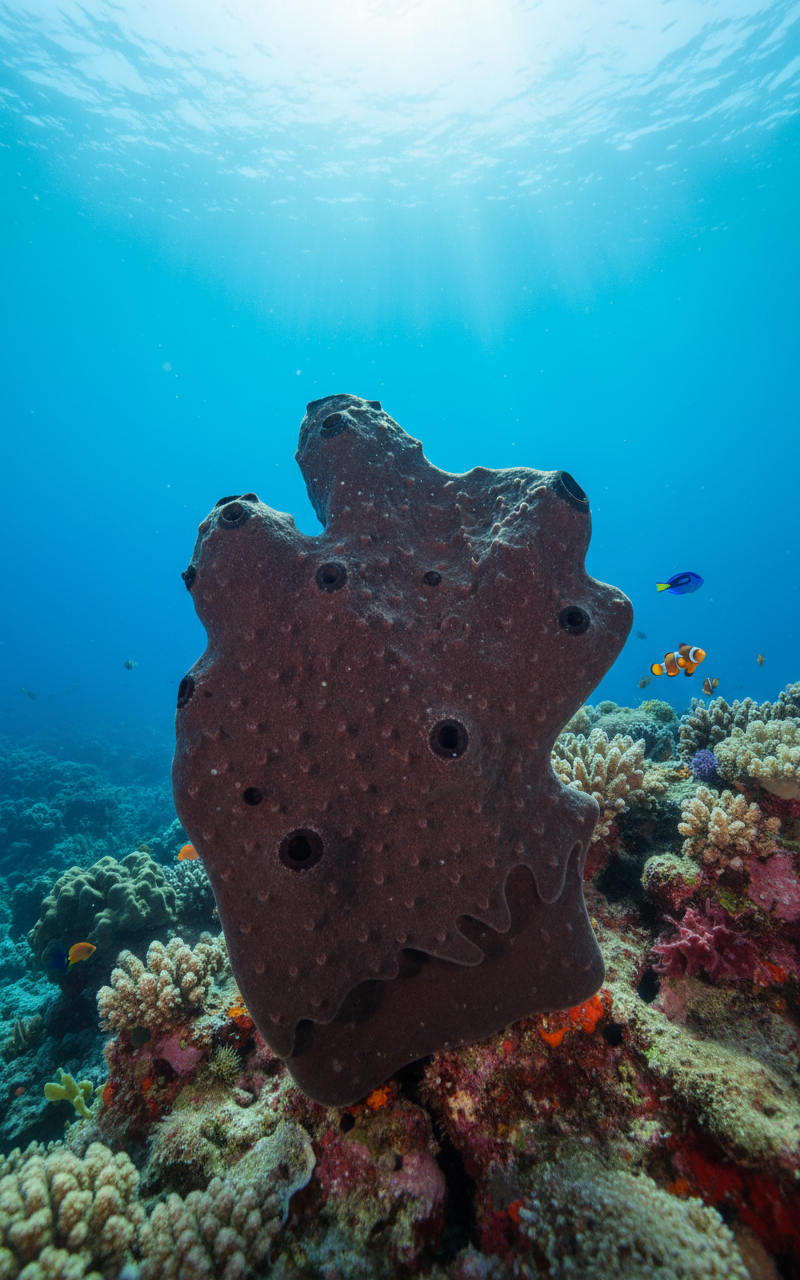Classification of Hircinia
- Phylum: Porifera (Pore-bearing aquatic animals with cellular grade organization)
- Class: Demospongiae (Sponges with skeletons comprised of spongin fibers and siliceous spicules)
- Order: Dictyoceratida (Sponges characterized by a skeleton mainly of spongin without siliceous spicules)
- Family: Irciniidae (Sponges characterized by dense fibrous skeletons and tough, leather-like texture)
- Genus: Hircinia
Hircinia is a genus of marine sponges, widely recognized for their commercial and ecological significance. These sponges belong to the family Irciniidae and are known for their leathery texture and complex fibrous skeletons.

Habit and Habitat
Hircinia species inhabit marine environments from intertidal zones to depths exceeding 20 meters. They are usually attached to rocky substrates, coral reefs, or within crevices and caves. Their leathery texture and flexible bodies make them well adapted to withstand moderate wave action and water currents.
Geographical Distribution
These sponges are widely distributed throughout the Indo-Pacific region, Mediterranean Sea, and Caribbean. They occupy warm temperate to tropical marine waters and are often found in habitats ranging from shallow coastal areas to deeper reef slopes.
General Characteristics
- Commonly called horny sponge.
- Sponge attains considerable size and rounded massive form with a number of conspicuous oscula.
- Oscula are mounted on raised region of sponge called as conules.
- Sponge is characterised by having peculiar filaments of unknown nature throughout the body.
- Skeleton consists of spongin fibres forming net-work like structures.
- Skeleton consists of spongin fibres.
- The body of Hircinia sponges is massive, lobate, or irregular in shape with a tough, leathery surface.
- Surfaces may appear smooth or slightly roughened due to the fibrous skeleton underneath.
- Coloration ranges from yellowish, brownish to dark olive or blackish shades.
- Skeleton consists mainly of spongin fibers forming a dense network providing structure and flexibility.
- They have a leuconoid canal system providing efficient water circulation and filtering capabilities.
- Reproduction occurs both sexually and asexually, with some species showing seasonal reproduction patterns.

Special Features
Hircinia is notable for its thick, flexible spongin matrix which imparts a characteristic tough, leather-like feel. This genus also produces bioactive compounds with antimicrobial and antifouling properties, of interest to biotechnology and pharmaceutical industries. Their spongin skeletons are utilized commercially though at a smaller scale compared to Hippospongia.
Identification
Hircinia can be identified by its leathery texture, massive and lobate shape, and the absence of siliceous spicules in the skeleton. Its typical habitat on rocky reefs, dark coloration, and morphological variability also aid in field identification.
References:
- https://www.youtube.com/watch?v=050heO7HFnA
- https://mlsu.ac.in/econtents/4190_practical-zoology-invertebrate.pdf
- https://marinespecies.org/porifera/porifera.php?p=taxdetails&id=1042599
- https://www.gbif.org/species/2239075
- http://eprints.cmfri.org.in/13926/1/Stony%20corals,%20sponges%20and%20reef%20fishes_Systematic%20account%20of%20diverse.pdf
- https://onlinelibrary.wiley.com/doi/full/10.1002/jmor.21460
- https://www.vliz.be/vmdcdata/narms/narms.php/images/narms.php?p=taxdetails&id=132356
- https://zookeys.pensoft.net/article/3774/element/2/16/
- http://www.marinespecies.org/aphia.php?p=taxdetails&id=165009
